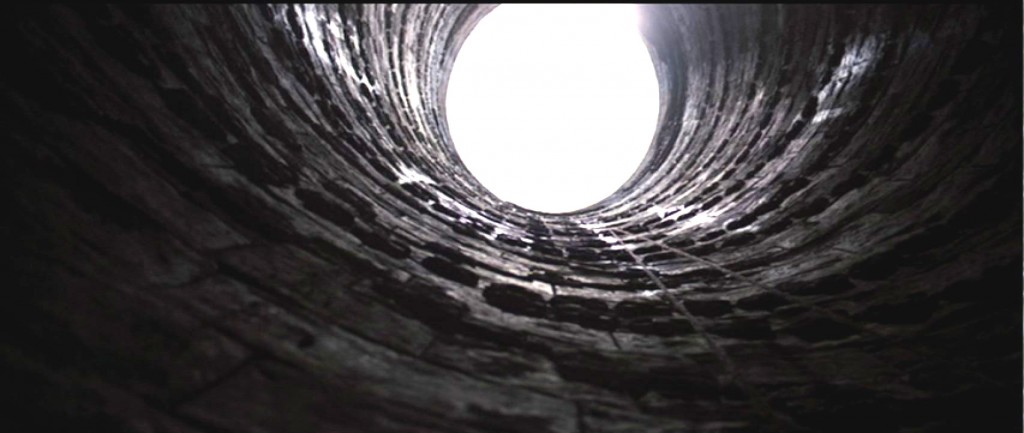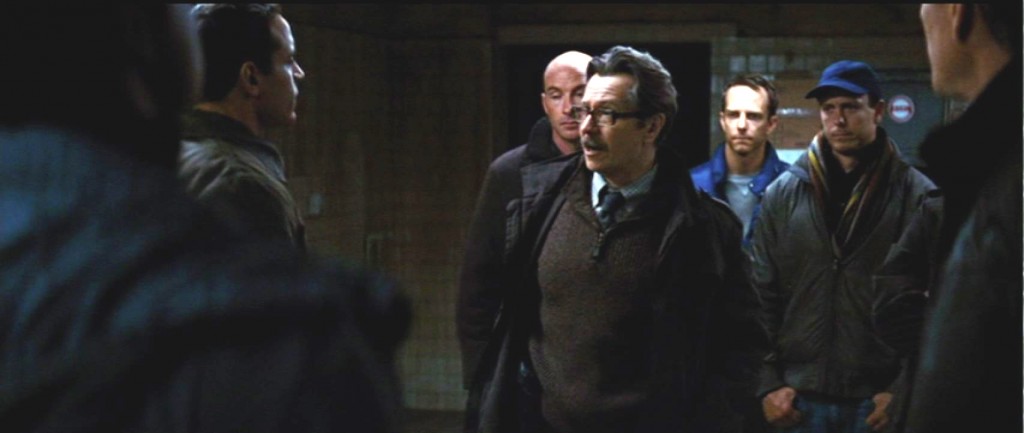Batman: The Dark Knight Rises part 12
Bruce is no longer broken but he is still in the pit. “Prisoner,” the only English-speaking guy in the place, warns him against escape, although everyone else in the pit seems really excited about it, they become a positive choir of helpful animals as he climbs the wall. (I still don’t know why he doesn’t pull the rope up after himself, tie a hook to it and use it as a grapple — where is Batman when you need him?) (However, major props to Bruce for taking a major fall with a rope tied around his waist after suffering a broken back.)
When pressed, Prisoner reveals an ooch more about the love-child of the mercenary and the warlord’s daughter — the child, he says, was “no ordinary child, a child born in Hell.” Bruce, he says, is not qualified to escape from the pit, he is a child of privilege, born in the light. Prisoner does not know, perhaps, that falling down a hole is old news to Bruce, although, to be fair, he was rescued from that original hole by his wealthy father. (I’m a little more concerned that Bane claims to have been “born in darkness,” since, as the reader must know by now, Bane is not the child of the pit. Was he, too, born in the pit?)
Back in Gotham, Gordon meets with a team of Special Forces guys and gives them an update on the situation on the ground (and under it). Three thousand police officers, Daytime Batmen all, are trapped in their own pit while fellow Daytime Batmen Blake and Gordon work to rescue them. (And anti-Daytime-Batman Foley stands around fretting.) The confab scene (and its accompanying montage) serves an expository purpose (to explain what’s going on regarding how the trapped police are still alive, how the bomb truck operates, where are the Wayne Enterprises executives living, etc), a textural purpose (to lend grit and immediacy to what is a largely fanciful conceit) and a philosophical one (to show how an evolved society works — civil servants, people dedicated to the public trust, work together to solve practical problems in practical ways). Bane wished to show how the GCPD is riddled with corruption, but the police here are showing the opposite — when the chips are down, they pull together, work well with other government organizations and pledge themselves to service.
Blake takes the Special Forces guys to see Lucius Fox and Miranda Tate, and they are immediately set upon by some of Bane’s army. (It’s great that Bane can get hardened criminals to all pull together into a tight, well-organized unit, a lot of warlords have trouble with that.) Blake gets Miranda and Lucius out of the way, but the Special Forces guys, and the rest of the Wayne board, are executed in public. Bruce, seeing his board members dangling from a bridge, tries again to escape the pit, and fails again. Blind Prisoner, acting as a kind of anti-Ra’s, counsels him on fear and the spirit, which, we might say, is Bruce’s thesis. Bruce says he’s not afraid of dying, per se, but afraid of dying in the pit “while my city burns with no one there to save it.” Noble, but again, he still sees Gotham as his own personal therapeutic test. His actions got Gotham into this mess, so it makes sense that he wants to undo it, but part of the theme of Rises is that Batman was never his job, that it was only hubris and self-regard that made him choose that path, which brought all the costumed freaks upon the city — Ra’s Al Ghul, the Scarecrow, the Joker, Two-Face and now Bane. In The Dark Knight, Alfred mentions that Bruce caused the Joker because he upset the status quo, which made the established mobsters make a deal with a man they didn’t fully understand, but that extends to the other villains as well — in order to “end crime” in Gotham, Bruce created a situation where super-crime could flourish.
Bruce tries a third time, this time without the rope to catch him if he falls. The crutch removed, he makes it to the crucial handhold. A swarm of celebratory bats swoops out of a hole at the last moment, giving Bruce the moral push he needs to escape the pit, as Act IV draws to a close.


I loved the stuff with Bruce in the prison. Part of the mythology that has always resonated with me is that Bruce is just a guy. He’s not a alien or someone blessed with super powers. He has to work to be stronger and smarter than villains. Sure, being rich helps and that’s a core part of the mythology. But just as he wouldn’t be Batman without the fancy gadgets, he wouldn’t be Batman without the dedication to shaping his body and mind into elite-performing tools.
What the prison does is strip away the benefits of the fancy gadgets. And by giving him something to overcome by just being Bruce Wayne, it made it emotionally satisfying for me. Perhaps I enjoyed it more than others because I brought preconceived notions regarding the mythology into the film. But this is what Batman is to me, overcome obstacles by working hard.
But that’s just what bothers me about Bruce in the pit. His back is broken, there’s no significant medical care, and he falls multiple times with a rope around his waist. A fall that would probably break the back of a perfectly healthy man. He doesn’t just get out of the pit with determination, he does so with superhuman toughness and recovery.
At the beginning of the movie, it’s made clear that his body is about worn out. It doesn’t make any sense that the Pit would rejuvenate him. (A Lazarus Pit it is not.)
Flying snowman!
See also Sheldon Cooper’s Superman theory, which pretty much makes the same argument, here:
http://www.youtube.com/watch?v=-PvwtS0htyk
1.
Bane is not the child of the pit. Was he, too, born in the pit?
Well, we could say the Bane identity is created in the pit. Both Bane and Batman get their masks/identities in pits, but only Bruce eventually learns to take off his mask, which Bane can never do. (Kind of like the Joker that way.)
2.
Although I really like these movies and your analysis of the arc from “it’s your fault, Bruce” to “it’s not your sole responsibility, Bruce,” I want to question your comment that Batman causes super-crime, only because the very first attack by a supervillain is Ra’s al Ghul’s economic destabilization of Gotham pre-Batman.
I thought that was a misstep in the first movie, to tie the League of Shadows into something that’s more the realm of daylight (or dusk) heros and criminals–that’s for the Daggetts and maybe the Laus of the world. Do you think that Ra’s economic gambit doesn’t qualify as supervillainy (precisely because it’s economic in method, even if the motivation is costumed freak-worthy)? I may have just argued myself into agreeing with you totally.
Considering that the League of Shadows’ ongoing supervillainy led to the destabilization of Gotham and thus the murder of Bruce’s parents, isn’t it more accurate to say that supercriminals created Batman rather than the other way around?
Perhaps the point of Batman isn’t that he creates freaks and supervillains, but that he stirs the pot enough so that they rise to the top to be directly confronted (instead of allowing them to hide under the surface and continue to ruin the world in anonymity). In which case, Bruce’s putting on a mask has the curious effect of causing evildoers to remove theirs.
The point can be made either way, I’m afraid. A bit of the old “Which came first, the chicken or the egg?” adage. Just one of many things which has always made Batman so fascinating to me.
Bruce, seeing his board members dangling from a bridge
I thought the people hanged on the bridge were specifically the Special Forces guys, put on display to show that if any outside help was again attempted to be smuggled in then they would suffer the same fate, to act as a deterrent. Bane said the nuke would be detonated if anyone crossed the bridge, and this was a final warning of sorts.
I was under the impression that the Special Forces guys died right there in the room, and the rest of the people, the civilians, were the Wayne board.
Yes, the Special Forces were killed there and then, but I saw Bane’s instruction as for them to be put on display, to show that they’d been spotted, caught, and killed. They weren’t really hanged, just their dead bodies made obvious to everyone, including TV cameras.
I hadn’t considered them being the Wayne board. It would be somewhat more brutal if it is, and in-line with Bane’s intention to punish the wealthy. But, then, every other member of the elite establishment is put before Scarecrow’s court.
Were the Special Forces bodies dangling from a bridge a reference to the contractors in Fallujah? (How could it not be?) Does that make Bane Zarqawi?